Main menu
Common skin conditions

NEWS
Join DermNet PRO
Read more
Quick links
Acrodermatitis continua of Hallopeau — extra information
Acrodermatitis continua of Hallopeau
Author: Ken Hiu-Kan Ip, Medical Student, University of Auckland, New Zealand, 2013.
Introduction Demographics Clinical features Causes Diagnosis Management Outcome
What is acrodermatitis continua of Hallopeau?
Acrodermatitis continua of Hallopeau (ACH) is a rare inflammatory disease characterised by pustular eruptions beginning in the tips of fingers and toes (digits). The pustules may vary in extent over a chronic, recurrent course.
The disease is named after the French dermatologist François Henri Hallopeau, who described the syndrome in 1880. It is also known as dermatitis repens, acrodermatitis perstans and acropustulosis.
Who is at risk of acrodermatitis continua of Hallopeau?
Acrodermatitis continua of Hallopeau is most common in adult females. However, it can also present in males, children and elderly.
What are the clinical features of acrodermatitis continua of Hallopeau?
Acrodermatitis continua of Hallopeau is often triggered by localised trauma or infection at the distal phalanx (the tip of the digit). 80% begin in only one digit, most commonly the thumb.
During acute flare-ups, the skin of the distal phalanx becomes red and scaly and develops small pustules. The pustules often join together and on bursting, reveal a painful, red and glazed area where new pustules then develop.
Pustulation of the nail bed and its growth site (matrix) can result in onychodystrophy (malformation) and anonychia (loss of nail).
Slowly, the disease can rarely spread proximally to affect the hand, forearm and/or foot. There may be osteolysis (destruction of bone) resulting in a wasted and tapered tip of finger or toe.
In adults, acrodermatitis continua of Hallopeau may evolve into generalised pustular psoriasis. The disease may also affect mucosal surfaces such as the conjunctiva, tongue and urethra.
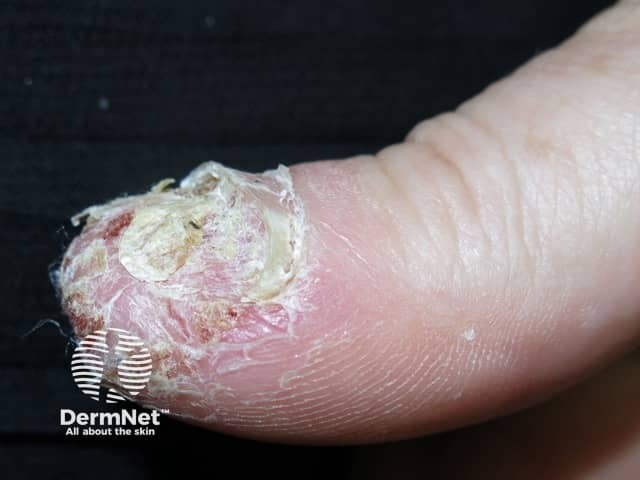
Acrodermatitis continua of Hallopeau
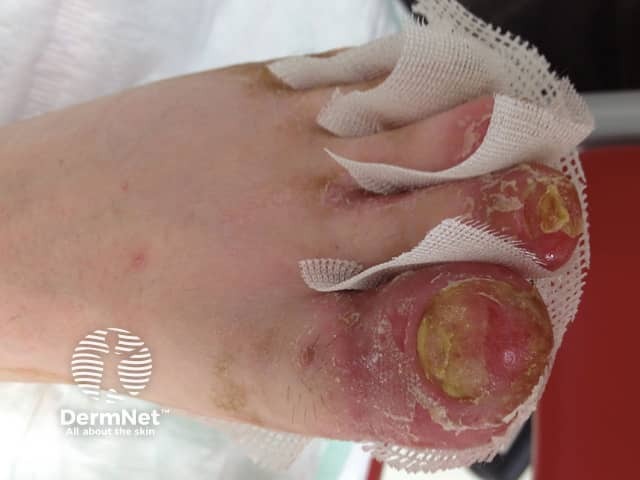
Acrodermatitis continua of Hallopeau

Acrodermatitis continua of Hallopeau
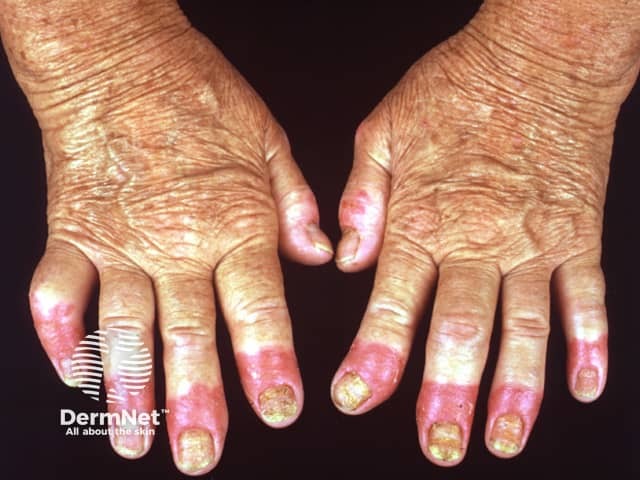
Acrodermatitis continua of Hallopeau
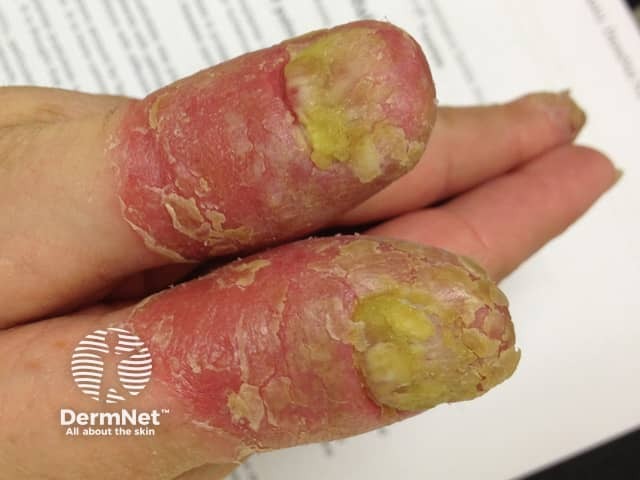
Acrodermatitis continua of Hallopeau
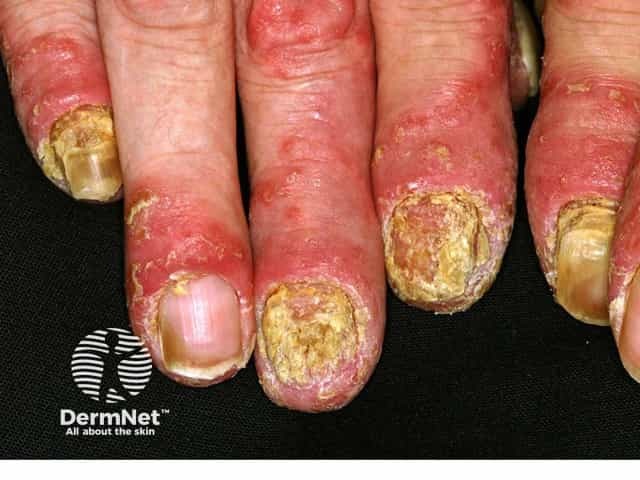
Acrodermatitis continua of Hallopeau
What causes acrodermatitis continua of Hallopeau?
The cause of acrodermatitis continua of Hallopeau is not completely understood. It is considered a variant of palmoplantar pustulosis and related to psoriasis. It is classified as an autoimmune disorder in which there is localised immune dysregulation in the skin.
How is acrodermatitis continua of Hallopeau diagnosed?
Acrodermatitis continua of Hallopeau is diagnosed based on clinical presentation and histological appearance of a skin biopsy examined under the microscope.
The characteristic histopathological feature is intra-epidermal spongiform pustules filled with neutrophils.
There are no specific tests to confirm the diagnosis. Other investigations to consider include Gram stain smear to exclude bacterial infection, and potassium hydroxide (KOH) preparation of the pustules to exclude fungal infection. A culture of pustular fluid is usually sterile, but secondary infection may also occur.
What is the management of acrodermatitis continua of Hallopeau?
Because acrodermatitis continua of Hallopeau is so rare, there is little evidence on which to base treatment decisions.
Some treatment options reported in the medical literature to be effective include:
Topical therapy
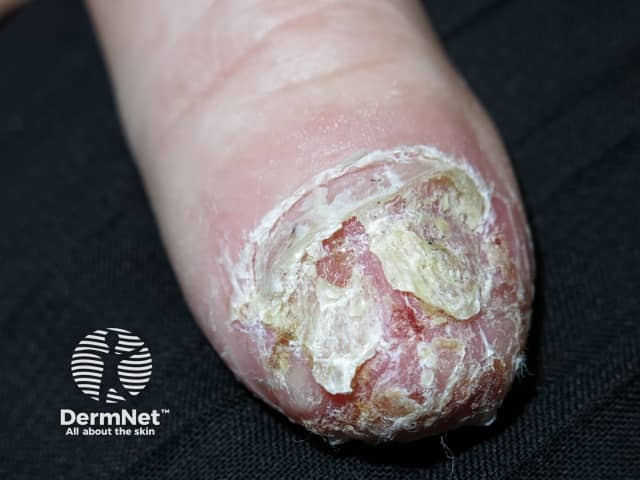
Before treatment
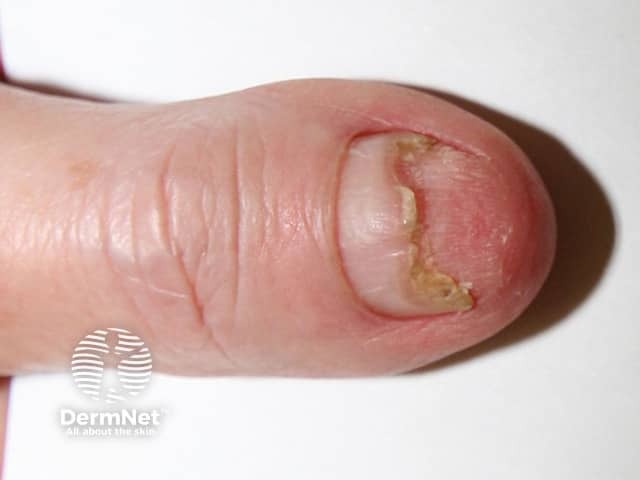
After use of clobetasol for 2 months
Systemic therapy
- Methotrexate
- Ciclosporin
- Acitretin
- PUVA (photochemotherapy) (usually bathwater PUVA )
- Tumour Necrosis Factor (TNF) Blockers (infliximab, adalimumab, etanercept). However, TNF blockers may also cause palmoplantar pustulosis and perhaps acrodermatitis of Hallopeau.
- The anti-IL-17 monoclonal antibody secukinumab has been reported to be effective in a case of acrodermatitis of Hallopeau
- High-dose brachytherapy has been reported effective in at least one case.
What is the prognosis?
Acrodermatitis continua of Hallopeau is a chronic disease that may eventually destroy the nail and underlying bone as described above. Though there are case reports of success with experimental agents such as infliximab, it is often refractory to treatment.
References
- Book: Textbook of Dermatology. Ed Rook A, Wilkinson DS, Ebling FJB, Champion RH, Burton JL. Fourth edition. Blackwell Scientific Publications.
- Sehgal VN, Verma P, Sharma S et-al. Acrodermatitis continua of Hallopeau: evolution of treatment options. Int. J. Dermatol. 2011;50 (10): 1195–211. PubMed
- Razera F, Olm GS, Bonamigo RR. Neutrophilic dermatoses: part II. An Bras Dermatol. 86 (2): 195–209. PubMed
- Pinard J, Vleugels RA, Kurtzman DJB, Devlin PM, Patel M. Novel Application of High-Dose-Rate Brachytherapy for Severe, Recalcitrant Acrodermatitis Continua of Hallopeau. JAMA Dermatol. Published online January 25, 2017. doi:10.1001/jamadermatol.2016.5142. Journal.
- Muggli D, Maul J, Anzengruber F, Fopp MW, Navarini AA. Secukinumab for Acrodermatitis Continua of Hallopeau. JAMA Dermatol. Published online January 25, 2017. doi:10.1001/jamadermatol.2016.5059. Journal.
On DermNet
